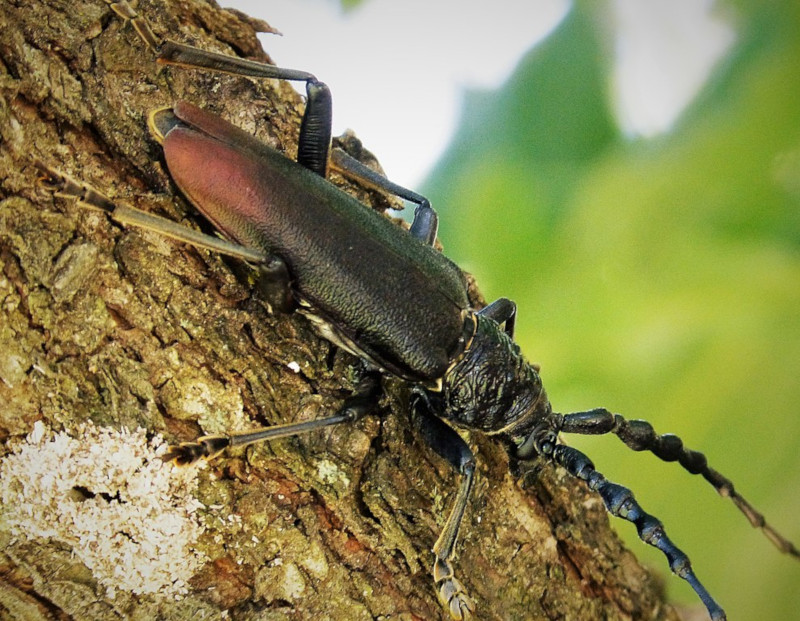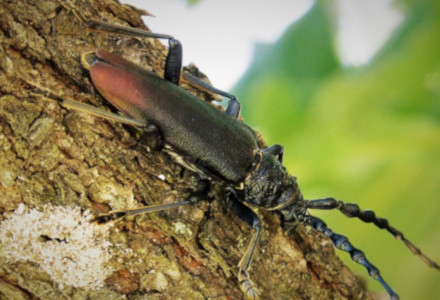
Photographer: gailhampshire
CC License: https://bit.ly/2EdyAkC
Great Capricorn Beetle Facts
- Firstly, the truly physically impressive animal known as the Great Capricorn Beetle qualifies as a member of the Longhorn family. Furthermore, in certain portions of its natural range, the amazing invertebrate currently remains considered the largest extant beetle. This interesting fact holds true partly because of the great size of its antennae. These really set it apart.
- Furthermore, the current population of this remarkable arthropod appears to be fairly stable overall. In this, the surprising creature quite fortunately stands out from many related species. However, its population density in specific portions of its endemic range appears to be declining. It also presently appears in the greatest numbers in France and Bulgaria.
- But sadly, not all is well with the marvelous beetle. That’s because, even in the various locations in which it still appears in abundance, it remains considered at risk. Like many other species in the world, the ever-growing risks of habitat loss and climate change appear to be its greatest threats. Due to these concerns the IUCN presently lists it as Vulnerable on its Red List of Threatened Species.
Related Articles
Tansy Beetle Golden Tortoise Beetle Christmas Beetle
Great Capricorn Beetle Physical Description
First of all, the Great Capricorn Beetle does have one thing in common with many other related species. That pertains to the general shape of the body itself. In fact, the creature evolved a generally elongated body shape. Not only that, but adults often attain the impressive body length of as much as 2.2 in (5.6 cm). This tendency holds true for members of both sexes.
Most notably, its antennae represent its most distinguishing physical feature. The astounding species does display the trait of sexual dimorphism. But, in it case, it does so in terms of antennae length. Among females, these roughly equal the length of the body. Among males, however, these often equal as much as twice the length of the body itself.
Further, in coloring, individuals primarily display the color black. This holds true of both the body and legs. However, the elytra of the arthropod sometimes presents a reddish-brown shade on the tips. The purpose this remains undetermined by entomologist, despite extensive study.
Finally, it also possesses a row of comparatively tough ridges along the abdomen. These it vigorously rubs against a hard surface, such as a tree branch. The insect does this to produce a surprisingly loud stridulation. This it uses to attract potential mates, during mating season.
- Kingdom: Animalia
- Phylum: Arthropoda
- Class: Insecta
- Order: Coleoptera
- Family: Cerambycidae
- Genus: Cerambyx
- Species: C. cerdo
Photographer: Bernard DUPONT
CC License: https://bit.ly/2RVmB3c
Great Capricorn Beetle Distribution, Habitat, and Ecology
First of all, the Great Capricorn Beetle inhabits an amazingly wide range of Europe. This astonishing member of the Coleoptera Order also appears in certain parts of Africa. In addition, within that natural range, it evolved as primarily endemic to low altitude forests. Only a small percentage of individuals of this species appear outside of this altitude range.
However, it has adapted to gardens, orchards, farmland, and yards as well. This insect practices great selectivity in the trees it inhabits. Specimens appear almost exclusively on various types of deciduous trees. Furthermore, the invertebrate generally prefers old and decaying trees. That’s because these serve as both a source of food and location for eggs.
Additionally, its diet remains entirely saproxylic in nature. Most individuals also commonly live, feed, and reproduce in the same location they hatched in. This characteristic leads to its being considered a harmful pest in certain parts of its range. Another reason is the fact that females lay as many as 300 eggs after mating.
Further, it does have some evolutionary differences between it and other similar species, however. That holds true partly due to the fact that both genders remain weak fliers. Due to this, it rarely takes flight. Finally, it possesses a typical lifespan ranging from 3-5 years, depending on environmental factors.
Species Sharing Its Range
Scottish Wildcat Plumed midge-orchid Death’s-head Hawkmoth
Check out our other articles on 5 Practically Perfect Penguins, Barndoor Skate, Bay of Islands, Acacia koa, Kemps Ridley Sea Turtle, Indian Bullfrog, Goliath Stick Insect

